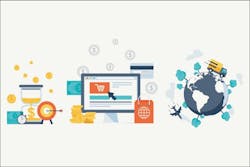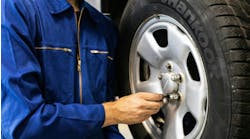Julian Bueres loves the Miami area. The parts manager at Porsche West Broward in Davie, Fla., lives for water sports in Biscayne Bay, for example.
Yet, professionally, Bueres sought to broaden his reach beyond his hometown earlier this decade. He wanted the ability to reach customers all over the globe. And he knew the Internet represented untapped potential for his employer.
The industry veteran wanted to try his hand at parts e-commerce, by way of his dealership’s website.
“You can benefit your local customers, giving them an option to purchase online,” Bueres says. “You’re tapping into another stream of income.
“And, when you have a website, it markets your business to the world.”
Over the last nine years, Bueres has learned that e-commerce can benefit a parts department in multiple other ways, too. Selling parts online can decrease obsolescence, increase absorption rate, and help a dealership fully meet customer demand.
And, many industry experts feel parts e-commerce will only increase in popularity in the coming years. According to Google statistics, there are 70 million searches online for auto parts per month. What’s more, in 2016, a Frost & Sullivan study noted that online parts and accessories sales were expected to double by 2020, reaching $50 billion.
Roughly a decade ago, Bueres suspected that the Internet held great potential for dealership parts departments. He soon learned, however, that implementing parts e-commerce must be handled carefully.
The Backstory
By 2009, Bueres had heard about competing dealerships “building big business” with the online sale of parts, using competitive pricing to increase revenue streams in areas, such as wholesale. While working for a past employer—a multi-franchise dealership in the Miami area—the parts manager carefully considered all the steps that would need to be taken to enable his department to sell OEM parts online.
The list was rather lengthy.
Staffing seemed like a potential obstacle. Informing customers of his employer’s “parts web store,” would take time. And, establishing a reliable customer base online would also require patience.
But, when his old employer signed off on allowing online parts sales, Bueres eventually saw significant progress.
The Process
Turns out, Bueres’ initial foray into parts e-commerce didn’t require an IT genius.
Bueres saw to it that his employer’s website included parts sales links—that his dealership’s website simply included a link to the parts department, plus a dropdown menu that requested visitors to “order parts.” Then, once that was clicked on, visitors were prompted to input contact information, along with the part they were seeking, and click “submit” (Bueres suggests using parts e-commerce companies like PartSites, RevolutionParts, or TradeMotion to aid in such website maintenance).
Eventually, he learned the value of including a hyperlink to quicken the online sales process, sending visitors directly to a dealership’s “website store,” rather than requiring a dealership employee to respond to an emailed request.
“That puts customers right there,” Bueres says, “and then they can go through the process of looking through the ‘store’ for what they need, and then they can make a purchase.”
For seven years, Bueres fine-tuned his employer’s online parts sales portal. He eventually learned these additional lessons about parts e-commerce:
You need to delegate. As any parts manager knows, there are only so many hours in a day to get work done. As a result, it’s important to delegate online parts selling responsibilities. Bueres feels it requires at least two employees to do parts e-commerce effectively—one staffer to handle orders (ideally, someone who’s tech-savvy), and one or more to get parts pulled, packed, and shipped.
“Depending on the volume, it’s largely assigned to whoever handles the retail counter or the wholesale sales,” Bueres says.
Shipping can be profitable. Assuming you can forge a solid working relationship with companies like UPS or FedEx, there’s money to be made when parts departments ship parts to online customers.
“We have a corporate account with FedEx, so we have excellent rates,”Bueres notes, “and, in the majority of shipments, it costs us less than what we charged. The rates are almost all calculated off the price of the part, with the exception of items that are large in size. This strategy, if done right, almost always results in a positive balance.”
Promote sales via search engines. There are two main ways to promote your dealership’s online parts sales capabilities, and they both involve utilizing search engines like Google, Bueres says. You can try to build your online brand over time, organically, for free. But, if you’re aiming to gain traction quickly, you’ll likely need to budget for pay-per-click advertising, which will move your facility’s parts e-commerce ads up toward the top of searches on Google, Bing, Yahoo, and the like.
Bueres suggests going the second route—but also soliciting the help of a third-party marketing company.
“Promotion is more important than anything; we tried to do it on our own, and right away we ran up $7,500 per month,” he says. “The digital marketing companies now, they just have a science to it, and now they know how to time it, with algorithms and stuff. So, they have a system to time it—when to turn it on, when to turn it off—and what specific keywords to use” for online ads.
Stay committed to it. Bueres has learned that it takes at least 3–6 months to get an online parts-selling setup to bear fruit. There will inevitably be smaller lessons that must be learned the hard way (for example, your website’s payment gateway simply must allow clients to utilize the increasingly popular PayPal these days, Bueres says).
Thus, he feels it’s imperative to get your dealership’s leaders to pledge a commitment to parts e-commerce before investing heavily in it.
“It’s going to take effort,” Bueres says. It might take “a good year to get it really solid, and to get a good following for it.”
The Results
By the time Bueres had left that multi-franchise dealership in Miami, in 2014, he had doubled his parts department’s retail sales numbers.
“You’re selling to the end user,” he explains. “So, we were able to increase our retail sales … we were doing about $25,000 and it went up to about $50,000 per month.”
Bueres arrived at Porsche West Broward’s new dealership in early 2016, and has wasted little time in implementing parts e-commerce. While he had to tweak his online parts selling payment gateway in early 2018, Bueres’ current facility has still managed incremental e-commerce success. Porsche West Broward produced $14,000 in online parts and accessory sales during one recent month, for example.
These days, when Porsche West Broward’s customers seek technical equipment and accessories like roof racks, or even apparel, they know that such purchases can be made with a few simple clicks of a mouse.
Parts e-commerce, Bueres says, “helps you with the accessory side of the business. It helps you promote it, and move that. … And another benefit: wholesale-wise, customers can just go on [the website], look up the parts themselves, and place the orders if they so wish.”
Ultimately, Bueres, whose current department has an inventory nearing $600,000, feels online parts selling is here to stay.
“Technology, and the business cycle, moves so fast now,” he says. “And, if you’re not going to embrace e-commerce, you’re going to get left behind.”



